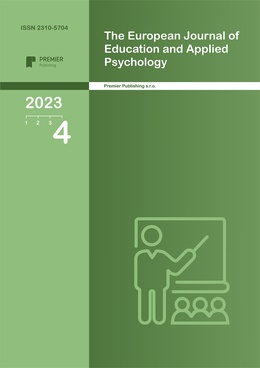Evaluation of Explosive Power and Flexibility in Elementary School Children of Tirana
Authors
Keida Ushtelenca, Danjela Cakuli

Share
Annotation
The primary goal of this study was to evaluate the effects of explosive power and flexibility in elementary school children. Out of the 64 schools from Tirana district, 4 schools were randomly chosen. Merely 148 kids aged 10 to 13 have completed both assessments (the follow-up evaluation occurs after a full academic year). The main purpose of this study was to evaluate the effects of explosive power and flexibility in elementary school children of the 2nd year of elementary school in Tirana city during one year period. To evaluate the explosive power in lower limbs we have used standing long jump, and for measuring flexibility we have used sit and reach test. The Statistical analyses is performed via “IBM Statistics 22”. The results, identify an increase by 11 cm from M1 to M2 in standing long jump, while Flexibility test results show that after one year there was no improvement in flexibility but a decrease of 1.03 cm.
The explosive power in children give us a clear picture of the progress of explosive power along one academic year, with an improvement of the power in the bigger muscles but on the contrary the results show a decrease with no improvement of flexibility. The children subjects of this this study did not acquire explosive power and flexibility, which call for specialized instruction in addition to their active engagement in recreational activities and general physical activity.
Keywords
Authors
Keida Ushtelenca, Danjela Cakuli

Share
References:
Artero, E. G., Ruiz, J. R., Ortega, F. B., España-Romero, V., Vicente-Rodríguez, G., Molnár, D., Gottrand, F., González‐Gross, M., Breidenassel, C., Moreno, L. A., & Gutiérrez, Á. (2011). Muscular and cardiorespiratory fitness are independently associated with metabolic risk in adolescents: the HELENA study. Pediatric Diabetes, 12(8), 704–712. https://doi.org/10.1111/j.1399-5448.2011.00769.x
Buehring, B., Krueger, D., & Binkley, N. (2010). Jumping mechanography: a potential tool for sarcopenia evaluation in older individuals. Journal of Clinical Densitometry, 13(3), 283–291. https://doi.org/10.1016/j.jocd.2010.04.002
Catley, M. J., & Tomkinson, G. R. (2011). Normative health-related fitness values for children: analysis of 85347 test results on 9–17-year-old Australians since 1985. British Journal of Sports Medicine, 47(2), 98–108. https://doi.org/10.1136/bjsports-2011-090218
Cohen, D. D., Gómez-Arbeláez, D., Camacho, P. A., Pinzón, S., Hormiga, C. M., Trejos-Suárez, J., Duperly, J., & López‐Jaramillo, P. (2014). Low Muscle Strength Is Associated with Metabolic Risk Factors in Colombian Children: The ACFIES Study. PLOS ONE, 9(4), e93150. https://doi.org/10.1371/journal.pone.0093150
Eurofit, (1993), Eurofit Tests of Physical Fitness, 2nd Edition, Strasbourg
Halme, T., Parkkisenniemi, S., Kujala, U. M., & Nupponen, H. (2009). Relationships between standing broad jump, shuttle run and Body Mass Index in children aged three to ei. PubMed, 49(4), 395–400. https://pubmed.ncbi.nlm.nih.gov/20087299
Jurča, R., LaMonte, M. J., Barlow, C. E., Kampert, J. B., Church, T. S., & Blair, S. N. (2005). Association of Muscular Strength with Incidence of Metabolic Syndrome in Men. Medicine and Science in Sports and Exercise, 37(11), 1849–1855. https://doi.org/10.1249/01.mss.0000175865.17614.74
Okely, A. D., Booth, M., & Chey, T. (2004). Relationships between Body Composition and Fundamental Movement Skills among Children and Adolescents. Research Quarterly for Exercise and Sport, 75(3), 238–247. https://doi.org/10.1080/02701367.2004.10609157
Ortega, F. B., Ruiz, J. R., Castillo, M. J., & Sjöstróm, M. (2007). Physical fitness in childhood and adolescence: a powerful marker of health. International Journal of Obesity, 32(1), 1–11. https://doi.org/10.1038/sj.ijo.0803774
Ortega, F. B., Ruiz, J. R., Castillo, M. J., & Sjöstróm, M. (2007b). Physical fitness in childhood and adolescence: a powerful marker of health. International Journal of Obesity, 32(1), 1–11. https://doi.org/10.1038/sj.ijo.0803774
Ruiz, J. R., Castro‐Piñero, J., Artero, E. G., Ortega, F. B., Sjöstróm, M., Suni, J., & Castillo, M. J. (2009). Predictive validity of health-related fitness in youth: a systematic review. British Journal of Sports Medicine, 43(12), 909–923. https://doi.org/10.1136/bjsm.2008.056499
Sauka, M., Priedite, I. S., Artjuhova, L., Lāriņš, V., Selga, G., Dahlström, Ö., & Timpka, T. (2010). Physical fitness in northern European youth: Reference values from the Latvian Physical Health in Youth Study. Scandinavian Journal of Public Health, 39(1), 35–43. https://doi.org/10.1177/1403494810380298
Smith, J., Eather, N., Morgan, P. J., Plotnikoff, R. C., Faigenbaum, A. D., & Lubans, D. R. (2014). The Health Benefits of Muscular Fitness for Children and Adolescents: A Systematic Review and Meta-Analysis. Sports Medicine, 44(9), 1209–1223. https://doi.org/10.1007/s40279-014-0196-4
Steene‐Johannessen, J., Kolle, E., Andersen, L. B., & Anderssen, S. A. (2013). Adiposity, aerobic fitness, muscle fitness, and markers of inflammation in children. Medicine and Science in Sports and Exercise, 45(4), 714–721. https://doi.org/10.1249/mss.0b013e318279707a
Stump, C. S., Henriksen, E. J., Wei, Y., & Sowers, J. R. (2006). The metabolic syndrome: Role of skeletal muscle metabolism. Annals of Medicine, 38(6), 389–402. https://doi.org/10.1080/07853890600888413
Vandorpe, B., Vandendriessche, J., Lefevre, J., Pion, J., Vaeyens, R., Matthys, S., Philippaerts, R., & Lenoir, S. (2011). The Korper coordination Test fur Kinder: reference values and suitability for 6–12-year-old children in Flanders. Scandinavian Journal of Medicine and Science in Sports, 21(3), 378-388. doi:10.1111/j.1600-0838.2009.01067.x
Vicente-Rodríguez, G., Jimenez-Ramirez, J., Ara, I., Serrano-Sánchez, J. A., Dorado, C., & Calbet, J. a. L. (2003). Enhanced bone mass and physical fitness in prepubescent footballers. Bone, 33(5), 853–859. https://doi.org/10.1016/j.bone.2003.08.003
Wijndaele, K., Duvigneaud, N., Matton, L., Duquet, W., Thomis, M., Beunen, G., Lefevre, J., & Philippaerts, R. (2007). Muscular strength, aerobic fitness, and metabolic syndrome risk in flemish adults. Medicine and Science in Sports and Exercise, 39(2), 233–240. https://doi.org/10.1249/01.mss.0000247003.32589.a6
Wilson, G. S., & Murphy, A. B. (1996). The use of isometric tests of muscular function in athletic assessment. Sports Medicine, 22(1), 19–37. https://doi.org/10.2165/00007256-199622010-00003
Wolfe, R. R. (2006). The underappreciated role of muscle in health and disease. The American Journal of Clinical Nutrition, 84(3), 475–482. https://doi.org/10.1093/ajcn/84.3.475


